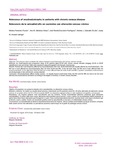Mostrar el registro sencillo del ítem
Relevancia de la onicodistrofia en pacientes con alteración venosa crónica
| dc.contributor.author | Perarnau-Pauner, Mónica | |
| dc.contributor.author | Giménez-Arnau, Ana María | |
| dc.contributor.author | Escudero-Rodríguez, José Román | |
| dc.contributor.author | Zalacaín-Vicuña, Antonio J. | |
| dc.contributor.author | Rossell-Garriga, Josep M. | |
| dc.date.accessioned | 2020-12-01T08:19:52Z | |
| dc.date.available | 2020-12-01T08:19:52Z | |
| dc.date.issued | 2020 | |
| dc.identifier.citation | Perarnau-Pauner, M., Giménez-Arnau, A. M., Escudero-Rodríguez, J. R., Zalacaín-Vicuña, A. J., & Rossell-Garriga, J. M. (2020). Relevancia de la onicodistrofia en pacientes con alteración venosa crónica. European Journal of Podiatry / Revista Europea De Podología, 6(1), 1-11. https://doi.org/10.17979/ejpod.2020.6.1.5685 | es_ES |
| dc.identifier.issn | 2445-1835 | |
| dc.identifier.uri | http://hdl.handle.net/2183/26858 | |
| dc.description.abstract | [Resumen] Objetivo: El propósito fue evaluar la relación entre onicodistrofia y la alteración venosa crónica. Material y métodos: Se realizó un estudio observacional y transversal con 83 pacientes entre 40 y 84 años afectados de alteración venosa crónica, en un grado clínico de C0 a C6 en la escala CEAP. La valoración ungueal se llevó a cabo mediante iconografía y onicoscopia. Resultados: Las mujeres padecen más onicodistrofia que los hombres. Ambas extremidades inferiores presentan igual afectación onicodistrófica. El primer dedo tiene mayor afectación onicodistrófica que el tercero, cuarto y quinto. En la extremidad inferior izquierda, el quinto dedo tiene mayor afectación que el segundo y cuarto. Para la extremidad inferior derecha, el primer dedo tiene mayor afectación que el tercero, cuarto y quinto. Existe una asociación positiva entre la onicodistrofia en los pies y la enfermedad venosa crónica. Conclusiones: La onicodistrofia se observa mayoritariamente entre las mujeres, afecta a ambas extremidades por igual, el primer y el quinto dedo suelen ser los más afectados, su prevalencia aumenta cuanto mayor es el grado de patología venosa crónica. | es_ES |
| dc.description.abstract | [Abstract] Objective: The purpose was to evaluate the relation between onychodystrophy and chronic venous disorder. Methods: An observational and prospective study of 83 patients aged 40-84 with chronic venous disorder (ranging C0-C6 in CEAP classification) was performed. Nails were assessed using photographs and through onychoscopy. Results: Women are more frequently affected by onychodystrophy than men. Both lower limbs are equally affected by onychodystrophy. The first toe is more affected by onychodystrophy than the third, fourth and fifth. In the left lower limb, the fifth toe is more affected than the second and fourth. In the right lower limb, the first toe is more affected than the third, fourth and fifth. A positive association exists between onychodystrophy in feet and chronic venous disorder. Conclusion: Onychodystrophy affects mostly women, it is equally found in both lower limbs, the first and the fifth toe tend to be the most affected and its prevalence increases according to the degree of severity of chronic venous disorder. | es_ES |
| dc.language.iso | spa | es_ES |
| dc.publisher | Universidade da Coruña | es_ES |
| dc.relation.uri | https://doi.org/10.17979/ejpod.2020.6.1.5685 | es_ES |
| dc.rights | Atribución-NoComercial-CompartirIgual 4.0 España | es_ES |
| dc.rights.uri | http://creativecommons.org/licenses/by-nc-sa/4.0/es/ | * |
| dc.subject | Onicodistrofia | es_ES |
| dc.subject | Enfermedad venosa crónica | es_ES |
| dc.subject | Onychodystrophy | es_ES |
| dc.subject | Chronic venous disease | es_ES |
| dc.title | Relevancia de la onicodistrofia en pacientes con alteración venosa crónica | es_ES |
| dc.title.alternative | Relevance of Onychodystrophy in Patients with Chronic Venous Disease | es_ES |
| dc.type | journal article | es_ES |
| dc.rights.accessRights | open access | es_ES |
| UDC.journalTitle | EJPOD: European Journal of Podiatry = Revista europea de podología | es_ES |
| UDC.volume | 6 | es_ES |
| UDC.issue | 1 | es_ES |
| UDC.startPage | 1 | es_ES |
| UDC.endPage | 11 | es_ES |






